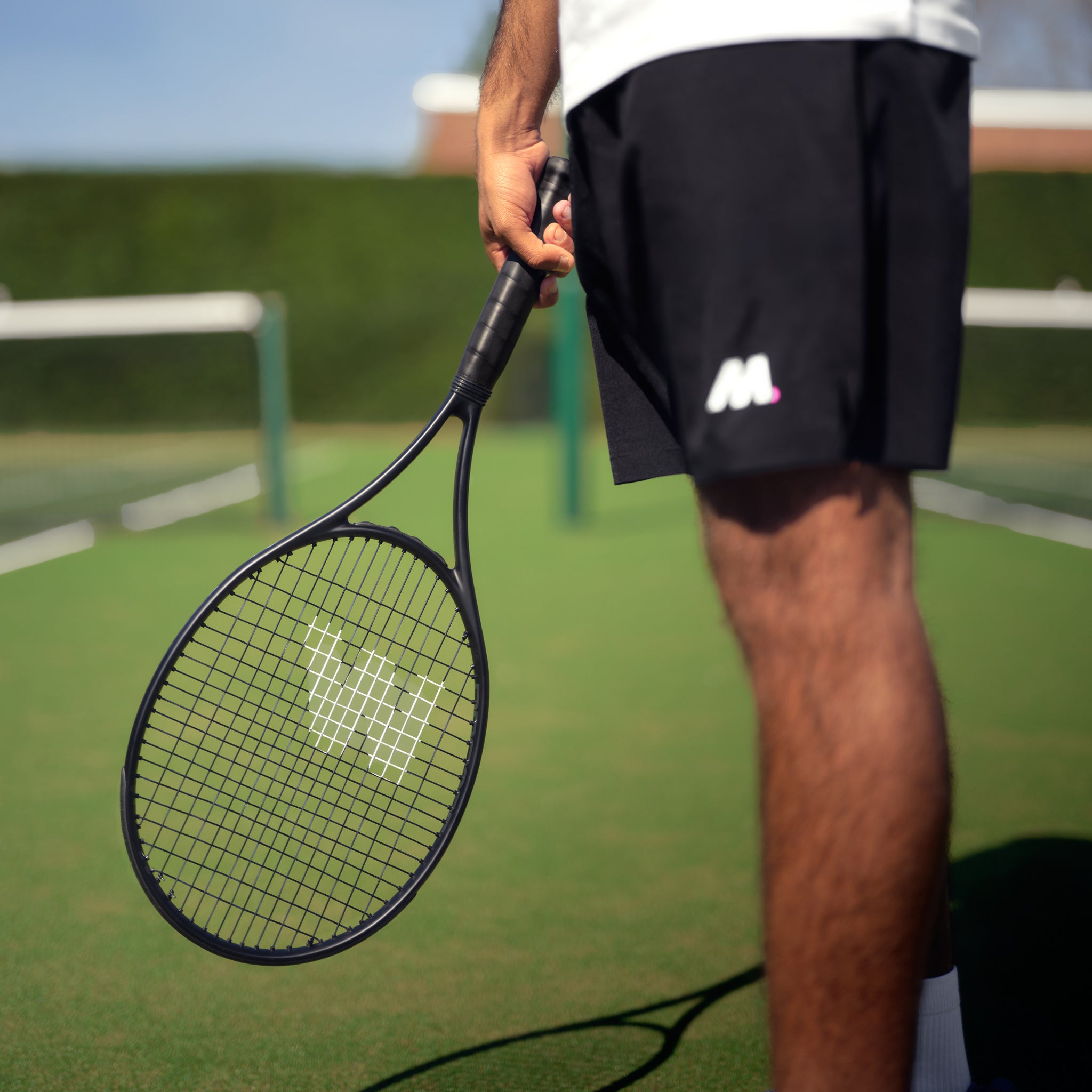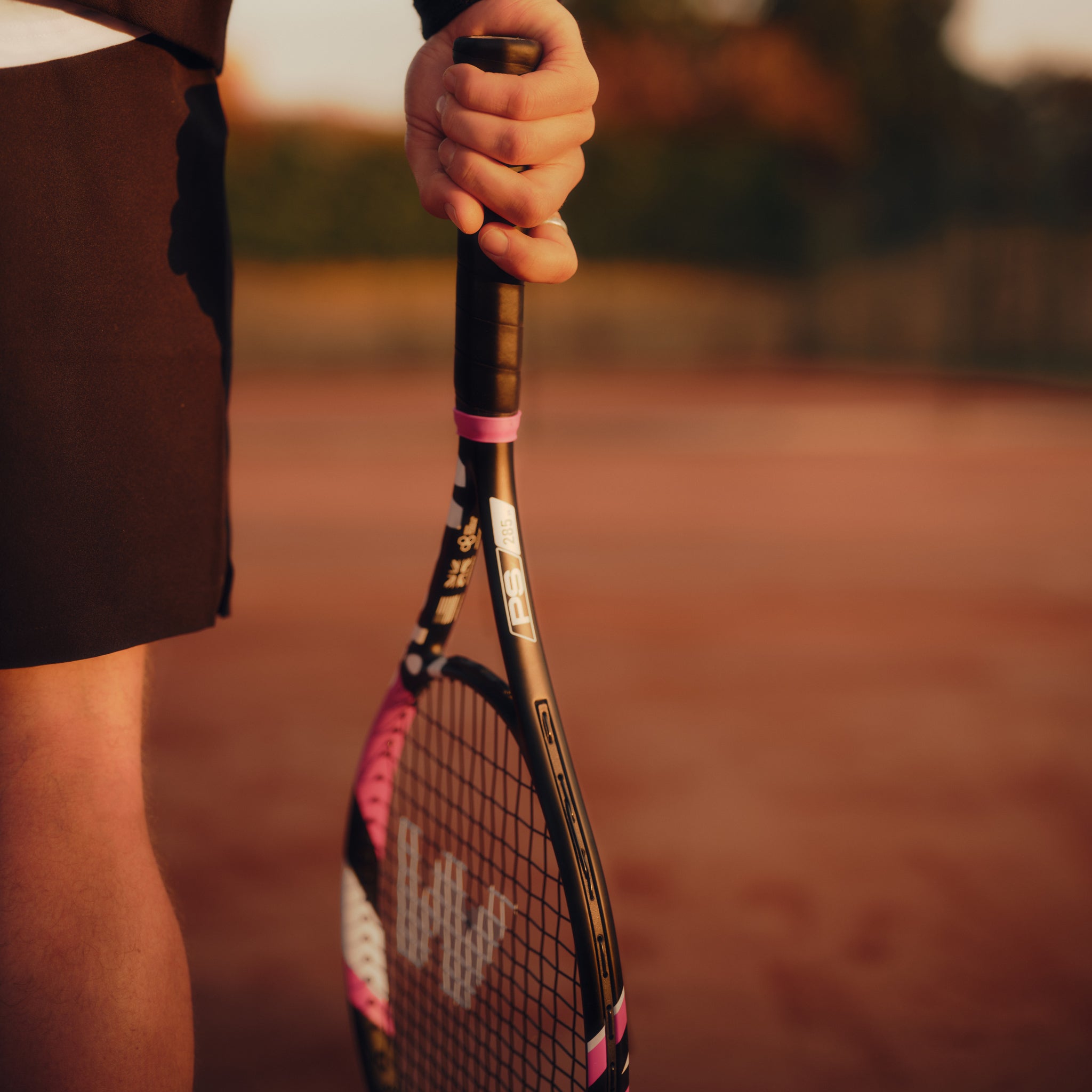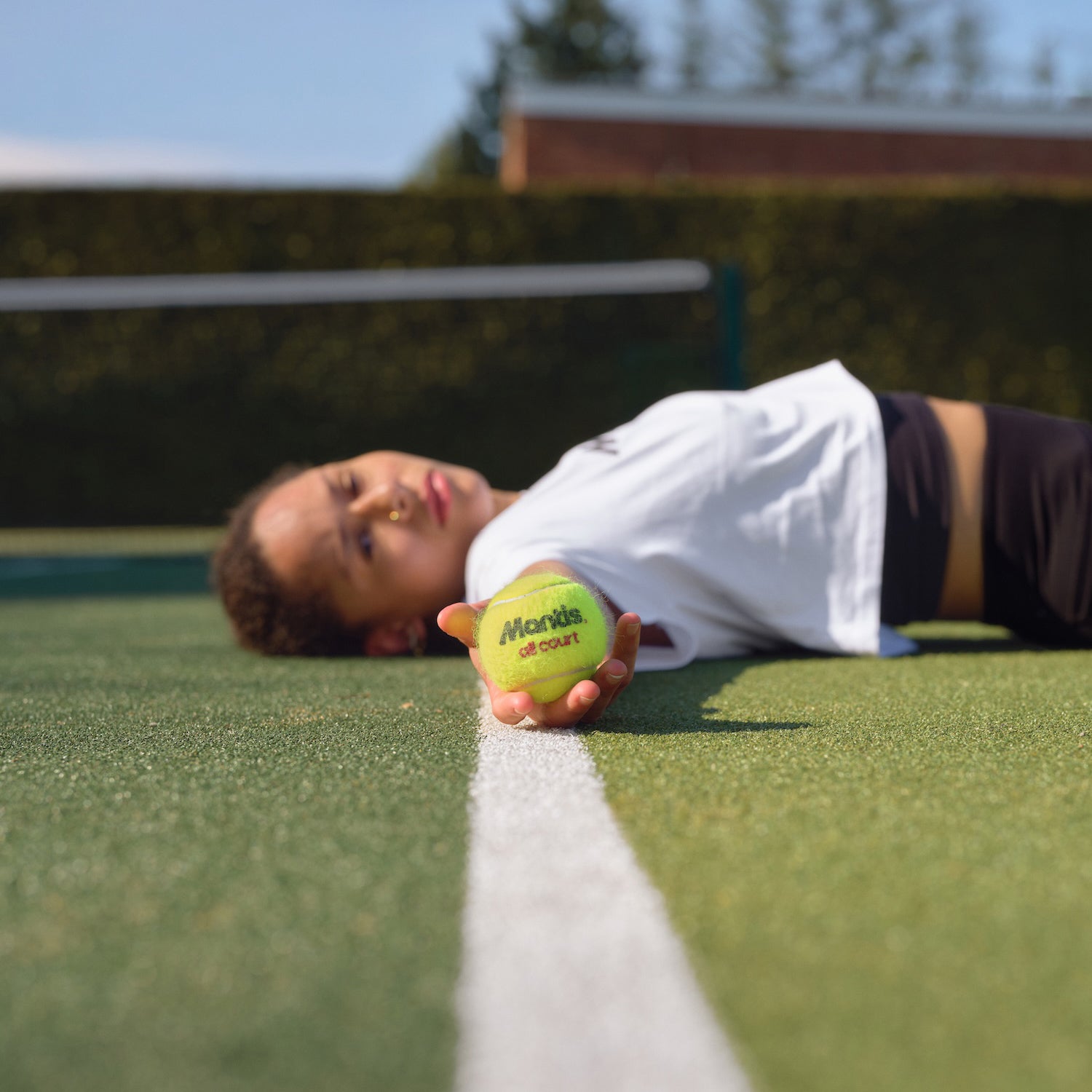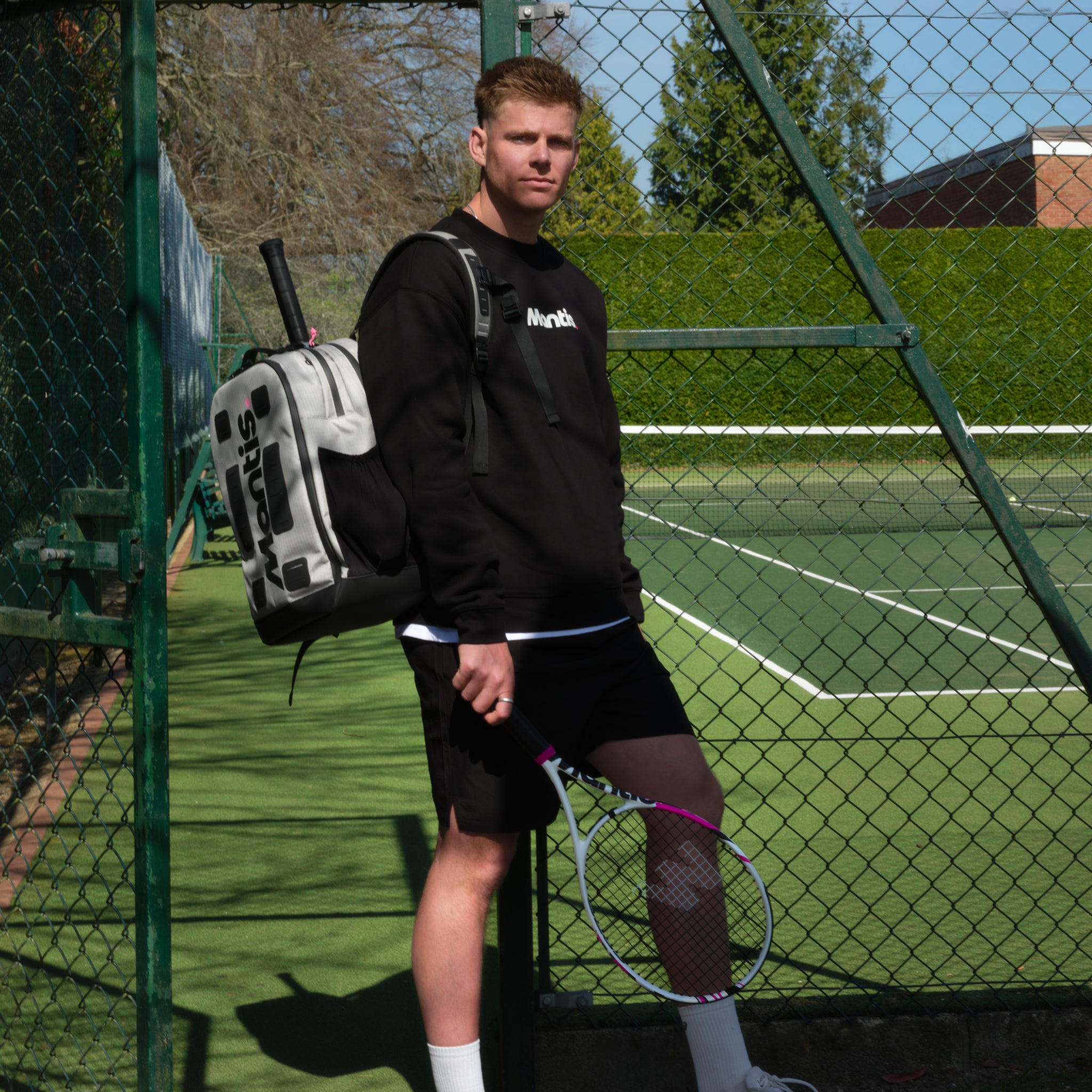
To really take your tennis game to the next level, you have to look beyond the court. Your performance during a match is built on the work you put in beforehand. A dedicated fitness for tennis programme isn't just about getting in shape; it's about building explosive power for your serve, having the stamina to endure those long, grinding rallies, and moving around the court with sharp precision. Here at Mantis, we believe that understanding how to choose the right tennis racket is a critical first step, because the right gear and your physical conditioning have to work together.
Building Your Fitness for Tennis Dominance
One of the biggest mistakes players make is spending all their time hitting balls while completely ignoring the physical engine that powers every single shot. Sure, hours of practice will polish your technique, but that flawless form won't mean much if your body gives out during the crucial points of a third set. A well-rounded fitness plan is the bedrock of elite performance.
This isn't about following a generic gym routine. We're talking about a plan that specifically targets the unique demands of tennis—hundreds of short, intense bursts of effort followed by brief recovery periods. Neglecting this specific type of conditioning is like trying to build a house on a weak foundation. It might look alright at first, but it won't hold up under pressure.
The Core Pillars of Tennis Fitness
To build a routine that actually gets results on the court, we need to focus on four key areas. Think of them as interconnected components; each one plays a distinct role in taking your game from good to great. If you ignore any one of these, you create a weak link in your athletic chain, which ultimately caps your potential and even increases your risk of injury.
- Cardiovascular Endurance: This is what keeps you going. It’s your ability to sustain energy through long, gruelling matches, making sure you’re just as fresh in the final set as you were in the first.
- Functional Strength: We're not talking about bodybuilding here. This is about developing practical power that translates directly into faster serves and heavier, more penetrating groundstrokes.
- Agility and Footwork: This pillar is all about how you move. It governs your ability to cover the court efficiently, change direction on a sixpence, and get yourself into the optimal position for every shot.
- Flexibility and Mobility: Absolutely essential for a full range of motion, from your service action to a low volley. It’s also a massive factor in preventing injuries, keeping you on the court day in, day out.
At Mantis, we see fitness as a piece of equipment, just as vital as your racket or strings. A physically prepared player holds a significant advantage before the first point is even played.
Developing these areas requires a structured and purposeful approach. It's not enough to just jog on a treadmill or lift a few weights without a clear goal. Every exercise and every drill should have a direct link to an action you perform on the court.
Let's break down each of these pillars, with some actionable steps to help you build a complete fitness programme from the ground up.
Mastering Endurance for Gruelling Matches
We've all been there. Deep into a third set, your legs feel like lead, your lungs are burning, and your opponent just seems to be getting stronger. Those long, hard-fought matches aren't just a test of your forehand; they're a true test of physical and mental stamina. The player who can maintain their level when it matters most often walks off the winner.
To outlast your rivals, you need to build a cardiovascular base designed specifically for tennis. Forget plodding along on a treadmill for an hour. True tennis endurance is all about mimicking the brutal stop-start nature of a real match. The focus has to be on drills that improve both your recovery between points and your explosive power during them.
This is where smart, targeted training comes in. Drills that copy the chaotic rhythm of a rally are infinitely more effective than just running for miles. By conditioning your body to handle repeated bursts of high-intensity effort, you’re ensuring your legs and lungs are just as strong in the final game as they were in the first. At Mantis, we see this as a non-negotiable part of serious training. For more on the business side of the sport, from facilities to equipment, the folks at racketbusiness.com have some excellent resources.
Tennis-Specific Cardio Drills
To build that match-ready endurance, we need to think beyond traditional cardio. The trick is to train both your aerobic system, which helps you recover between points, and your anaerobic system, which fuels those short, powerful movements like chasing down a drop shot.
Here are a few of our go-to drills:
- High-Intensity Interval Training (HIIT): This is the foundation. Think short, all-out bursts of effort followed by brief recovery. A classic example is sprinting flat-out for 20 seconds then walking for 40 seconds. Repeat that cycle 10-15 times and you’ll feel it.
- Shuttle Runs: Nothing mimics on-court movement better. Set up cones at the baseline, service line, and net. Sprint from the baseline to the net and back, making sure to touch each line. This drill directly simulates the constant forward-and-back sprints in a tough point.
- On-Court Ghosting: This is all about rehearsing movement patterns without a ball. Shadow a cross-court rally, moving corner to corner, remembering to throw in your split-steps and recovery movements. You're training your body to move efficiently without even thinking about it.
A well-conditioned player doesn't just survive long matches; they thrive in them. When you see your opponent starting to fade, your superior endurance becomes your biggest weapon, allowing you to maintain your technique and decision-making under immense pressure.
Sample Weekly Tennis Cardio Plan
Of course, just knowing the drills isn’t enough. You have to weave them into your weekly schedule to see real progress. Consistency is what turns good fitness into a genuine on-court advantage.
Here’s a simple plan to get you started. Remember to adjust it based on your own fitness level and any upcoming tournaments. The goal is to balance those high-intensity days with proper recovery to avoid burnout.
| Day | Activity | Duration/Intensity | Focus |
|---|---|---|---|
| Monday | HIIT Session | 20 minutes: 30s max effort sprints, 60s walking recovery | Anaerobic Power |
| Wednesday | Ghosting Drills | 15 minutes: Shadowing rally patterns with split-steps | Tennis-Specific Movement |
| Friday | Shuttle Runs | 3 sets of 5 repetitions: Full court sprints with rests | Agility & Speed Endurance |
| Sunday | Active Recovery | 30-45 minutes: Light jog or brisk walk | Aerobic Base & Recovery |
This schedule provides a solid mix of explosive training and aerobic conditioning, ensuring you're building the engine you need to dominate those gruelling three-setters.
Developing Explosive Strength and Power
Let's get one thing straight: real power in tennis doesn't come from just your arm. It's a full-body explosion that starts from the ground, travels up through your legs and core, and is finally channelled out through your racket. Building this kind of functional, explosive strength is what turns a decent shot into a heavy, court-penetrating weapon.
This isn’t about building beach muscles; it’s about becoming a more dynamic and powerful athlete. The aim is to train your body to generate force quickly – that’s the very definition of power. By focusing on the right exercises, you can add serious pace to your serve and real weight to your groundstrokes, putting your opponents on the defensive from the very first strike. We dive deep into this philosophy in our complete guide to tennis strength training.
Building a Powerful Foundation
To generate the kind of power needed for booming serves and rapid court coverage, your strength training has to be specific. In tennis, everything revolves around the kinetic chain—the sequence of movements from your feet to your fingertips that creates force. A weak link anywhere in that chain, whether it's your ankles or your shoulders, will bleed power and cap your potential.
That's why we have to prioritise compound exercises that work multiple muscle groups at once. These movements mirror the integrated, full-body actions you use on court. While tennis has its unique demands, many of the foundational principles of building lower-body power are universal. Here are the non-negotiables for your routine:
- Squats and Deadlifts: These are the undisputed kings for building lower-body strength. They create a powerful base in your glutes, quads, and hamstrings – the real engine behind your serve.
- Lunges: Fantastic for developing single-leg strength and stability. This is crucial for staying balanced when you're hitting on the run.
- Overhead Press: This one is key for building robust shoulder strength and stability, which is vital for both power in the service motion and for keeping injuries at bay.
The core is the vital link that transfers energy from your lower body to your upper body. A strong, stable core ensures that no power is lost along the way, making every movement more efficient and forceful.
Translating Strength into Rotational Power
Once you've built a solid base of strength, the next phase is all about converting it into tennis-specific power. This means shifting your focus to rotational and explosive movements that directly mimic the actions of serving and hitting groundstrokes.
This is where exercises like medicine ball throws are worth their weight in gold. They teach your body to generate rotational force from your hips and core, which has a direct and immediate impact on your racket head speed. It’s a perfect example of why tennis fitness must be highly specific.
It's no surprise that so many people are focused on getting their bodies right for the sport. In the UK alone, over 4 million people play tennis each year, with around 1 million hitting the courts weekly across roughly 16,800 courts. Huge events like Wimbledon, which pulls in 500,000 fans, only fuel that passion for the game and the fitness it demands.
For developing power, your set and rep schemes need to change. Forget high-rep bodybuilding sets. You should be aiming for 3-5 sets of 4-6 repetitions. The focus here is on moving the weight with maximum speed while maintaining perfect form. This approach trains your nervous system to fire your muscles explosively, and that’s the secret to unlocking your true power on the court.
Enhancing Your Agility and Footwork
Getting to the ball is only half the battle. How you get there, and the position you're in when you arrive, dictates the quality of your shot. Here at Mantis, we see superior agility and footwork as the difference-maker—it's what transforms a desperate defensive scramble into a point-winning offensive opportunity.
This isn't just about raw speed. It's about efficiency, balance, and that explosive first step that puts you in the perfect position to strike. Efficient movement makes the court feel smaller, letting you cover more ground with less effort. To really dive deep, check out our guide on essential tennis footwork drills.
This section is all about the practical drills that will get you faster, improve your balance, and quicken your reactions.
Mastering Directional Changes with Cone Drills
Tennis is a game of constant, unpredictable changes in direction. Your ability to slam on the brakes, pivot, and then accelerate into a new direction is absolutely fundamental. Cone drills are the perfect tool for this, forcing you to lower your centre of gravity and drive powerfully off your outside leg.
A classic and incredibly effective setup is the "T-Drill." Place three cones in a T-shape on the baseline. You'll sprint forward to the top cone, shuffle laterally to one side cone, touch it, then shuffle all the way across to the other before backpedalling to where you started. In one simple sequence, you’ve just rehearsed every primary movement pattern you'll need in a match.
Building Faster Feet with Agility Ladders
If you're looking for one of the best investments for your footwork, get an agility ladder. It works by training your nervous system to fire more rapidly, which improves your coordination and makes your feet feel noticeably lighter and quicker on the court. The secret is to stay on the balls of your feet, keeping every movement crisp and precise.
Try incorporating these key ladder drills into your warm-ups:
- Single-Foot Hops: Hop through each square of the ladder on one foot, then come back on the other. This is fantastic for building single-leg stability and explosive power.
- Ickey Shuffle: A staple lateral movement drill where you step side-to-side through the ladder in an "in-in-out" pattern. This movement directly mirrors the small, crucial adjustment steps you make right before hitting a groundstroke.
- Lateral High Knees: Face sideways and move down the ladder, driving your knees up high with each step. This drill is brilliant for improving your coordination while moving laterally under pressure.
The split-step is the most important movement in tennis, yet it's often the most neglected. It's that small, preparatory hop you take just as your opponent strikes the ball, priming your muscles to explode in any direction. Consciously practising this is a game-changer.
Improving Reaction with the Split-Step
Every great mover on the pro tour begins their response to a shot with a perfectly timed split-step. This simple hop pre-loads your leg muscles, allowing for a much faster reaction to wherever your opponent hits the ball.
To work on this, grab a partner and have them stand at the net, simulating a volley or groundstroke. Your only job is to time your split-step with their swing motion and then explode towards a designated cone. This drill forges a direct link between a visual cue and your physical reaction, which is exactly what you need to sharpen your on-court instincts.
This focus on sport-specific fitness is becoming more common as the game's popularity surges. A recent Sport England survey found that 915,000 adults in the UK were playing tennis regularly between 2021 and 2022. That's a huge 43% increase over the previous year, showing just how many people are getting serious about improving their game.
Why Flexibility and Injury Prevention Are Your Secret Weapons
If you want a long and successful tennis career, it all boils down to one simple thing: staying healthy. A smart fitness for tennis plan doesn't just focus on hitting harder or running faster; it puts just as much effort into preventing injuries before they happen. At Mantis, we see flexibility, mobility, and proper recovery as non-negotiable parts of the game for anyone serious about their performance.
This proactive approach is more critical than ever. Tennis is booming in the UK right now. The Lawn Tennis Association recently reported that a staggering two million adults are playing every month – the highest number they've ever seen. What's even more impressive is that 41% of these players are female, with women's participation jumping by 34% in 2022 alone. With more people on the court, smart injury prevention becomes everyone's responsibility.
The All-Important Dynamic Warm-Up
Walking onto the court cold is a fast track to pulling a muscle. Forget a gentle jog; you need a dynamic warm-up. This means using active movements that get your body ready for the specific, explosive actions you'll be doing in a match. It’s all about getting blood flowing, waking up your nervous system, and taking your joints through their full range of motion.
Set aside a good 10-15 minutes before you even hit a ball. Your routine should mirror the movements you'll make during a point.
- Leg Swings (Forward and Sideways): These are fantastic for opening up your hips, which are the engine room for all your rotational power.
- Walking Lunges with a Twist: This move fires up your glutes and quads while adding that torso rotation you need for solid groundstrokes.
- Arm Circles and Shoulder Rotations: These are absolutely essential for prepping the delicate rotator cuff muscles for the strain of serving and smashing overheads.
Your Post-Match Cool-Down and Recovery Ritual
Once the last point is played, the work isn't over. Your focus needs to switch immediately to recovery. This is the perfect time for static stretching, where you hold a stretch for 20-30 seconds. Your muscles are warm and pliable, making it the ideal moment to improve your long-term flexibility and kickstart the repair process.
We see it all the time: players pack up their bags and leave without a cool-down. Those five minutes you spend stretching can be the difference between waking up sore and stiff or feeling fresh for your next hit.
Make sure you target the key areas for tennis players: your shoulders (stretching the chest and the back of the shoulder), your hips (pigeon pose is a game-changer), and your lower back.
But recovery goes beyond just stretching. A foam roller can be your best friend for working out knots and easing muscle soreness. To really minimise your downtime, it's worth exploring all the tools available, including professional options like sports recovery treatments like acupuncture and cupping. And of course, never forget the foundations: proper hydration and nutrition are what make all your recovery efforts truly effective.
Weaving Fitness Into Your Weekly Routine
Knowing the right exercises is a great start, but the real magic happens when you weave them into a consistent weekly schedule. At Mantis, we've seen countless players transform their game by creating a balanced programme that prevents overtraining while still pushing their limits.
A smart plan doesn’t just pile on more work; it integrates your on-court practice with targeted off-court sessions for strength, endurance, and flexibility. This creates a sustainable routine that fuels continuous improvement.
The secret is to think in seasons, adjusting your focus and intensity based on where you are in your competitive calendar. A pre-season week should feel completely different from one in the middle of a tournament run.
Designing Your Training Week
Always build your schedule around your time on the court. Your off-court training is there to support your tennis, not leave you too shattered to hit a decent forehand. We like to think of it this way: strength days build the engine, and tennis practice is where you learn to drive it.
A well-rounded week could look something like this:
- Strength Training: Aim for two to three sessions per week, hitting those big compound movements. If you can, schedule these on days when you don't have a tough match or an intense hitting session.
- Cardio & Endurance: Two sessions a week works well. Try one high-intensity interval (HIIT) session to build that explosive, anaerobic fitness for long rallies, and one longer, steadier session to build your aerobic base.
- Agility & Footwork: This is easy to fit in. Just bolt five to ten minutes of drills onto your warm-up before you even pick up a racket. It’s a simple habit that keeps your movement sharp and instinctive.
Adjusting Your Plan for the Season
You can't go flat-out all year. Your training has to evolve with the seasons to make sure you peak at the right time and give your body the rest it desperately needs.
- Pre-Season: This is your building phase. The volume and intensity are high because you're laying a strong fitness foundation for the months ahead. You'll be spending a lot of time on strength and endurance, really pushing your physical boundaries before the competitive matches kick off.
- In-Season: Once you're playing tournaments, everything shifts to maintenance. Training volume drops right down to keep you fresh for match day. Sessions become shorter, sharper, and are all about maintaining strength and power, not building it. Recovery is now your number one priority.
- Off-Season/Recovery: Time for active rest. You'll likely play a lot less tennis and maybe focus on other activities you enjoy. It's the perfect window to work on any imbalances or niggling weaknesses with corrective exercises, ensuring you start the next pre-season healthy and hungry.
One of the biggest mistakes we see players make is training with the same brutal intensity all year round. It's a one-way ticket to burnout and injury. Smart scheduling ensures you're at your physical best when it counts: standing on the baseline, waiting for the serve.
This visual guide breaks down a simple but incredibly effective sequence for your post-match recovery, which should be a non-negotiable part of every weekly plan.
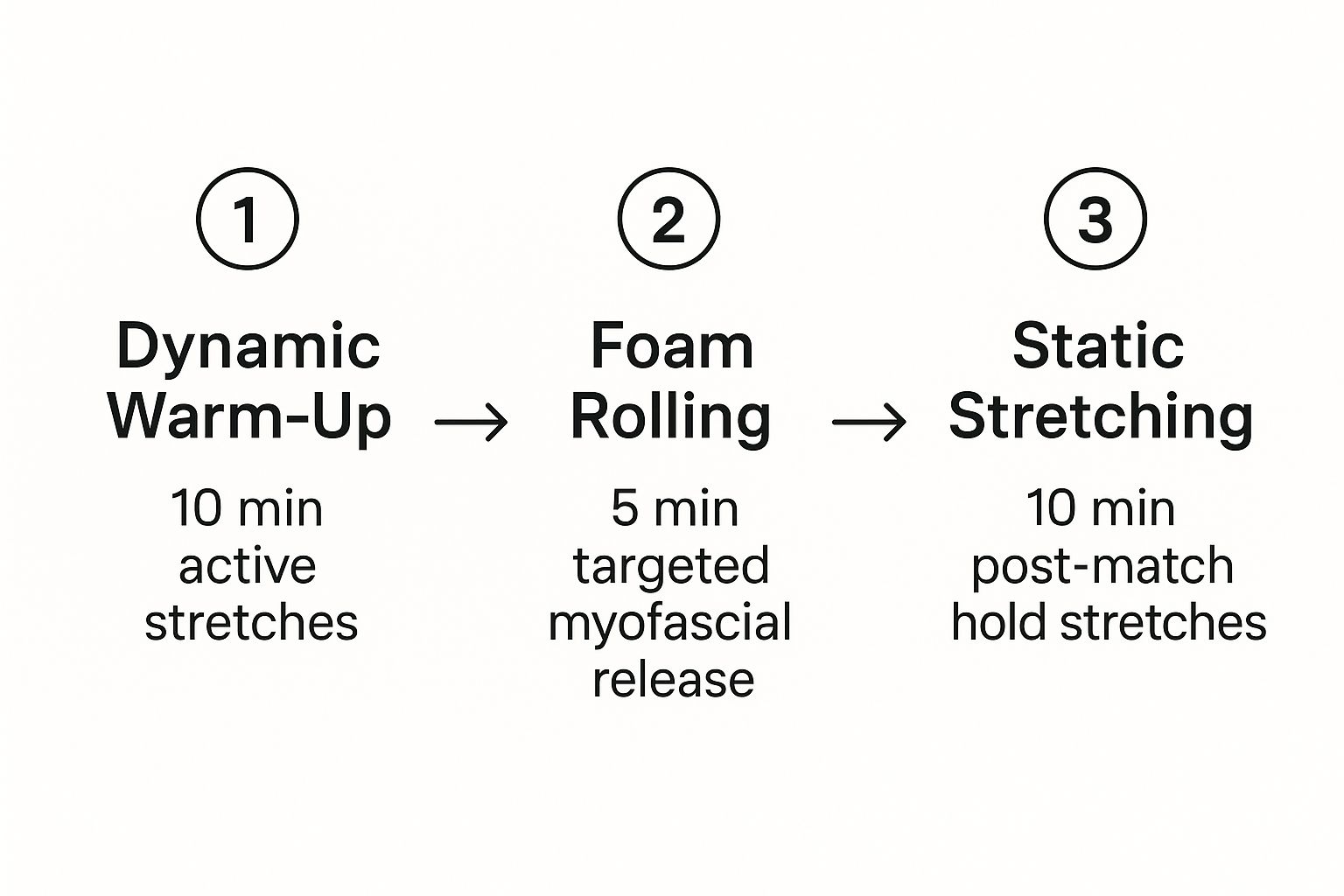
As you can see, a quick, structured cool-down like this can make a world of difference to your muscle recovery and long-term flexibility.
Your Tennis Fitness Questions Answered
When you start taking your off-court training seriously, a lot of questions pop up. It's totally normal. At Mantis, we get asked about the nuts and bolts of tennis fitness all the time, so we've put together answers to some of the most common ones. We want to help you train smarter, not just harder.
Think of this as a quick chat with a coach, clearing up the confusion so you can build a routine that actually makes a difference on the court. And while you're dialling in your fitness, it's a good time to think about your gear too – something we cover in our guide on when to change tennis rackets.
How Often Should I Be Doing Strength Training?
For the average club or competitive player, hitting the weights two to three times a week is the sweet spot. This is enough to build real strength and power without leaving you too sore to play or practice properly.
The key is scheduling. You need to give your body time to recover, so try to leave at least one full day between sessions. A big mistake is doing a heavy leg day right before a match – you'll feel it in the third set, and not in a good way. Keep your strength work separate from your most important on-court days.
Should I Still Lift Weights During the Tennis Season?
Absolutely, but you need to shift your mindset. In-season, your goal isn't to build new strength; it's to maintain what you've already built. Think of it as protecting your investment from the off-season.
Your workouts should be shorter and less demanding. Instead of pushing for personal bests, you're just reminding your muscles to stay strong. One or two focused sessions a week is usually plenty to prevent you from losing power as the season wears on.
Don't make the classic error of dropping all strength work once the matches start. You'll feel strong in week one, but by the time the finals roll around, that drop-off in power and resilience can be the difference between winning and losing.
What's the Best Thing to Eat Before a Match?
Your pre-match meal is pure fuel. You're looking for complex carbohydrates for slow-release energy, plus a bit of lean protein. You can't go wrong with something like a bowl of porridge with berries or a grilled chicken sandwich on wholemeal bread.
Timing is everything. Eat your main meal about two to three hours before you play. This gives you enough time to digest everything properly, so you feel light and energised, not bloated. Steer clear of anything too fatty, greasy, or heavy on the fibre, as that's a recipe for discomfort mid-match.
Should I Do My Cardio or Strength Work First?
This really comes down to your main goal for that particular session. If you're purely focused on building your stamina, do your cardio first when you're freshest.
However, for most tennis players, the priority is explosive power. For that, you should do your strength training first. Lifting requires good form and a sharp nervous system, both of which take a hit if you're already tired from a long run. Do your lifting, then finish up with a shorter, high-intensity cardio burst.
At Mantis, we know that smart training and the right equipment go hand in hand. We design our rackets, balls, and gear for players who are serious about their game, focusing on performance and precision without the hype. Take a look at our collection and feel the difference for yourself.
